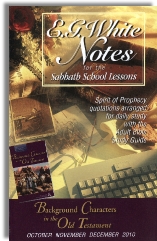|
||||||||||||||
Commentary on "Uriah: Faith of a Foreigner"
Day 4: Tuesday, November 2, 2010 - A Foreigner in Israel
Overview
Today’s lesson brings Uriah back into focus. This time his status as an alien in Israel is compared with the assimilation of other non-Israelites such as Ruth and Rahab. Rightly emphasized is the way in which this assimilation in Israel took place, giving the context of God’s interdictions regarding marriage outside of the community of Israel. As it happened with Ruth and supposedly with Rahab and Uriah, the assimilation involved not only marriage but also the adoption of Israel’s religion. Faith in Yaweh—or rather, the lack of it—was the element that was at the basis of God’s interdiction regarding marriage between Israelites and non-Israelites, believers and unbelievers.
At the end of today’s lesson there are questions intended to demonstrate how our own spiritual genealogy through Christ brings us, strangers from Israel, into full members into full membership in God’s chosen people.
Observations
Still, aliens like Uriah do not fit properly into the portrait of New Covenant believers. Uriah, Rahab, and Ruth became full members of the Old Covenant, adopting all 613 laws of Torah. They lived under the typological “Do this and you shall live” (Galatians 3:12) works principle of the Old Covenant, a shadow pointing forward to the substance belonging to Christ (Colossians 2:17). New Covenant believers are no longer living under the Old Covenant shadows. Jesus Christ fulfilled the works principle, “Do this”, and because He acted in our behalf, “you shall live”, the New Covenant believers are blessed with the gift of eternal life. While it is true that Uriah, Rahab, and Ruth, by their faith in the future Messiah foreshadowed in the Old Covenant, received eternal life on the same basis that New Covenant believers receive their eternal inheritance, their temporary earthly life was marked by the national, temporary mosaic covenant. Their lives were marked and governed by the law principle of works, a life under the shadows.
Because the law, which was the shadow of future things, functioned as a constant reminder of sins for the Old Covenant believers (Hebrews 10:1-3), the experience of those believers differed significantly from the experience of New Covenant believers. Through the repetition of sacrifices and also by conditioning God’s blessings on their performance of duties, the law imposed an unbearable yoke that was removed only when Christ came (Acts 15:10). The least believer in the New Covenant is greater than the greatest prophet of the Old Covenant (Matthew 11:11).
Copyright 2010 BibleStudiesForAdventists.com. All rights reserved. Revised October 30, 2010. This website is published by Life Assurance Ministries, Glendale, Arizona, USA, the publisher of Proclamation! Magazine. Contact email: BibleStudiesForAdventists@gmail.com.
The Sabbath School Bible Study Guide and the corresponding E.G. White Notes are published by Pacific Press Publishing Association, which is owned and operated by the Seventh-day Adventist church. The current quarter's editions are pictured above.
Official Adventist Resources
Standard Edition Study Guide Week 6
Teacher's Edition Study Guide Week 6
Easy Reading Edition Study Guide Wk 6
Search the Complete Published Ellen G. White Writings


